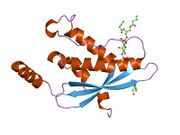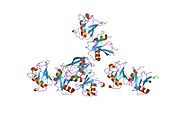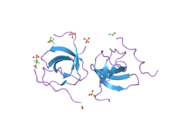Biology:Neutrophil cytosolic factor 4
Neutrophil cytosol factor 4 is a protein that in humans is encoded by the NCF4 gene.[1][2]
Function
The protein encoded by this gene is a cytosolic regulatory component of the superoxide-producing phagocyte NADPH-oxidase, a multicomponent enzyme system important for host defense. This protein is preferentially expressed in cells of myeloid lineage. It interacts primarily with neutrophil cytosolic factor 2 (NCF2/p67-phox) to form a complex with neutrophil cytosolic factor 1 (NCF1/p47-phox), which further interacts with the small G protein RAC1 and translocates to the membrane upon cell stimulation. This complex then activates flavocytochrome b, the membrane-integrated catalytic core of the enzyme system. The PX domain of this protein can bind phospholipid products of the PI(3) kinase, which suggests its role in PI(3) kinase-mediated signaling events. The phosphorylation of this protein was found to negatively regulate the enzyme activity. Alternatively spliced transcript variants encoding distinct isoforms have been observed.
Clinical significance
GWAS studies showed that Crohn's disease patient with certain SNPs in NCF4 are more susceptible to get Crohn's disease.[3] Crohn's patient with rs4821544 variants showed a decreased reactive oxygen species after stimulation with GM-CSF which is a proinflammtory cytokine.[4]
Interactions
Neutrophil cytosolic factor 4 has been shown to interact with Ku70,[5] Neutrophil cytosolic factor 1[6][7][8] and Moesin.[9]
References
- ↑ "Genomic structure, chromosomal localization, start of transcription, and tissue expression of the human p40-phox, a new component of the nicotinamide adenine dinucleotide phosphate-oxidase complex". Blood 88 (7): 2714–21. Nov 1996. doi:10.1182/blood.V88.7.2714.bloodjournal8872714. PMID 8839867.
- ↑ "Entrez Gene: NCF4 neutrophil cytosolic factor 4, 40kDa". https://www.ncbi.nlm.nih.gov/sites/entrez?Db=gene&Cmd=ShowDetailView&TermToSearch=4689.
- ↑ "NADPH oxidase complex and IBD candidate gene studies: identification of a rare variant in NCF2 that results in reduced binding to RAC2". Gut 61 (7): 1028–35. 2012. doi:10.1136/gutjnl-2011-300078. PMID 21900546.
- ↑ "Linking risk conferring mutations in NCF4 to functional consequences in Crohn's disease". Gut 61 (7): 1097; author reply 1097–8. 2012. doi:10.1136/gutjnl-2011-301344. PMID 22027479.
- ↑ "The Ku70 autoantigen interacts with p40phox in B lymphocytes". J. Cell Sci. 112 ( Pt 4) (4): 503–13. Feb 1999. doi:10.1242/jcs.112.4.503. PMID 9914162.
- ↑ "Architecture of the p40-p47-p67phox complex in the resting state of the NADPH oxidase. A central role for p67phox". J. Biol. Chem. 277 (12): 10121–8. Mar 2002. doi:10.1074/jbc.M112065200. PMID 11796733.
- ↑ "Small angle neutron scattering and gel filtration analyses of neutrophil NADPH oxidase cytosolic factors highlight the role of the C-terminal end of p47phox in the association with p40phox". Biochemistry 40 (10): 3127–33. Mar 2001. doi:10.1021/bi0028439. PMID 11258927.
- ↑ "p40(phox) down-regulates NADPH oxidase activity through interactions with its SH3 domain". J. Biol. Chem. 272 (14): 9141–6. Apr 1997. doi:10.1074/jbc.272.14.9141. PMID 9083043.
- ↑ "The NADPH oxidase components p47(phox) and p40(phox) bind to moesin through their PX domain". Biochem. Biophys. Res. Commun. 289 (2): 382–8. Nov 2001. doi:10.1006/bbrc.2001.5982. PMID 11716484.
Further reading
- "p40phox: the last NADPH oxidase subunit". Blood Cells Mol. Dis. 35 (2): 291–302. 2006. doi:10.1016/j.bcmd.2005.06.010. PMID 16102984.
- "The essence of operating room nursing. Paramedical personnel". Australas Nurses J 7 (1): 44–5, 63–4. 1977. PMID 243433.
- "Assembly of the phagocyte NADPH oxidase: binding of Src homology 3 domains to proline-rich targets". Proc. Natl. Acad. Sci. U.S.A. 91 (22): 10650–4. 1994. doi:10.1073/pnas.91.22.10650. PMID 7938008. Bibcode: 1994PNAS...9110650L.
- "Oligo-capping: a simple method to replace the cap structure of eukaryotic mRNAs with oligoribonucleotides". Gene 138 (1–2): 171–4. 1994. doi:10.1016/0378-1119(94)90802-8. PMID 8125298.
- "A novel cytosolic component, p40phox, of respiratory burst oxidase associates with p67phox and is absent in patients with chronic granulomatous disease who lack p67phox". Biochem. Biophys. Res. Commun. 199 (3): 1378–87. 1994. doi:10.1006/bbrc.1994.1383. PMID 8147882.
- "p40phox, a third cytosolic component of the activation complex of the NADPH oxidase to contain src homology 3 domains". Biochem. J. 296 ( Pt 3) (3): 557–61. 1993. doi:10.1042/bj2960557. PMID 8280052.
- "Mechanisms of NADPH oxidase activation: translocation of p40phox, Rac1 and Rac2 from the cytosol to the membranes in human neutrophils lacking p47phox or p67phox". Biochem. J. 314 ( Pt 2) (2): 409–12. 1996. doi:10.1042/bj3140409. PMID 8670049.
- "Translocation of guinea pig p40-phox during activation of NADPH oxidase". Biochim. Biophys. Acta 1277 (3): 217–25. 1996. doi:10.1016/s0005-2728(96)00099-0. PMID 8982388.
- "p40(phox) down-regulates NADPH oxidase activity through interactions with its SH3 domain". J. Biol. Chem. 272 (14): 9141–6. 1997. doi:10.1074/jbc.272.14.9141. PMID 9083043.
- "Cytosolic phox proteins interact with and regulate the assembly of coronin in neutrophils". J. Cell Sci. 110 ( Pt 24) (24): 3071–81. 1997. doi:10.1242/jcs.110.24.3071. PMID 9365277.
- "The 40-kDa component of the phagocyte NADPH oxidase (p40phox) is phosphorylated during activation in differentiated HL60 cells". Eur. J. Biochem. 249 (2): 531–9. 1997. doi:10.1111/j.1432-1033.1997.00531.x. PMID 9370364.
- "Construction and characterization of a full length-enriched and a 5'-end-enriched cDNA library". Gene 200 (1–2): 149–56. 1997. doi:10.1016/S0378-1119(97)00411-3. PMID 9373149.
- "p40(phox) is phosphorylated on threonine 154 and serine 315 during activation of the phagocyte NADPH oxidase. Implication of a protein kinase c-type kinase in the phosphorylation process". J. Biol. Chem. 273 (46): 30097–103. 1998. doi:10.1074/jbc.273.46.30097. PMID 9804763.
- "The Ku70 autoantigen interacts with p40phox in B lymphocytes". J. Cell Sci. 112 ( Pt 4) (4): 503–13. 1999. doi:10.1242/jcs.112.4.503. PMID 9914162.
- "Demonstration of the interaction of thioredoxin with p40phox, a phagocyte oxidase component, using a yeast two-hybrid system". Immunol. Lett. 68 (1): 155–9. 1999. doi:10.1016/S0165-2478(99)00045-0. PMID 10397171.
- "Identification of a splice variant mRNA of p40phox, an NADPH oxidase component of phagocytes". FEBS Lett. 455 (3): 257–61. 1999. doi:10.1016/S0014-5793(99)00905-9. PMID 10437784.
- "The DNA sequence of human chromosome 22". Nature 402 (6761): 489–95. 1999. doi:10.1038/990031. PMID 10591208. Bibcode: 1999Natur.402..489D.
- "Complementation of NADPH oxidase in p67-phox-deficient CGD patients p67-phox/p40-phox interaction". Eur. J. Biochem. 267 (4): 1059–67. 2000. doi:10.1046/j.1432-1327.2000.01097.x. PMID 10672014.
- "Small angle neutron scattering and gel filtration analyses of neutrophil NADPH oxidase cytosolic factors highlight the role of the C-terminal end of p47phox in the association with p40phox". Biochemistry 40 (10): 3127–33. 2001. doi:10.1021/bi0028439. PMID 11258927.
 |








